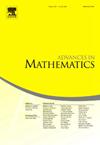Blow-ups and normal bundles in connective and nonconnective derived geometries
IF 1.5
1区 数学
Q1 MATHEMATICS
引用次数: 0
Abstract
This work presents a generalization of derived blow-ups and of the derived deformation to the normal bundle from derived algebraic geometry to any geometric context. The latter is our proposed globalization of a derived algebraic context, itself a generalization of the theory of simplicial commutative rings and due to Bhatt–Mathew and Raksit.
One key difference between a geometric context and ordinary derived algebraic geometry is that the coordinate ring of an affine object in the former is not necessarily connective. When constructing generalized blow-ups, this not only turns out to be remarkably convenient, but also leads to a wider existence result. Indeed, we show that the derived Rees algebra and the derived blow-up exist for any affine morphism of stacks in a given geometric context. However, in general the derived Rees algebra will no longer be connective, hence in general the derived blow-up will not live in the connective part of the theory. Unsurprisingly, this can be solved by restricting the input to closed immersions. The proof of the latter statement uses a derived deformation to the normal bundle in any given geometric context, which is also of independent interest.
Besides the geometric context which extends algebraic geometry, the second main example of a geometric context is an extension of analytic geometry as based on categories of Ind-Banach spaces or modules. The latter is a recent construction, and includes many different flavors of analytic geometry, such as complex analytic geometry, non-Archimedean rigid analytic geometry and analytic geometry over the integers. The present work thus provides derived blow-ups and a derived deformation to the normal bundle in all of these, which is expected to have many applications.
连接和非连接派生几何中的膨胀束和正常束
这项工作提出了从派生代数几何到任何几何环境的派生爆破和派生变形到法向束的推广。后者是我们提出的一个衍生代数背景的全球化,它本身是简单交换环理论的推广,由于巴特-马修和拉克西特。几何环境与普通派生代数几何之间的一个关键区别是,前者中仿射物体的坐标环不一定是连接的。在构造广义爆破时,这不仅非常方便,而且可以得到更广泛的存在性结果。事实上,我们证明了在给定的几何环境下,对于任何栈的仿射态射,都存在派生的Rees代数和派生的blow-up。然而,一般来说,推导出的Rees代数将不再是连接的,因此,通常推导出的爆破将不会存在于理论的连接部分。不出所料,这可以通过将输入限制为封闭沉浸来解决。后一种说法的证明在任何给定的几何环境中使用法向束的派生变形,这也是独立的兴趣。除了扩展代数几何的几何背景之外,几何背景的第二个主要例子是基于Ind-Banach空间或模块类别的解析几何的扩展。后者是最近才建立起来的,包含了许多不同风格的解析几何,如复解析几何、非阿基米德刚性解析几何和整数解析几何。因此,目前的工作提供了所有这些正常束的派生爆破和派生变形,预计将有许多应用。
本文章由计算机程序翻译,如有差异,请以英文原文为准。
求助全文
约1分钟内获得全文
求助全文
来源期刊

Advances in Mathematics
数学-数学
CiteScore
2.80
自引率
5.90%
发文量
497
审稿时长
7.5 months
期刊介绍:
Emphasizing contributions that represent significant advances in all areas of pure mathematics, Advances in Mathematics provides research mathematicians with an effective medium for communicating important recent developments in their areas of specialization to colleagues and to scientists in related disciplines.
 求助内容:
求助内容: 应助结果提醒方式:
应助结果提醒方式:


